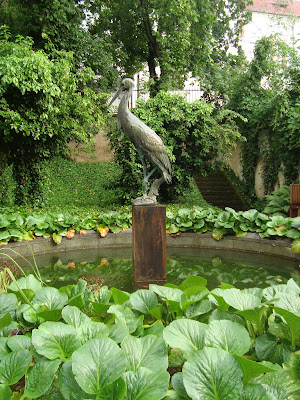 |
| Seated Woman-1933- Vincenc Makovský |
The last Museum Night did not bring
any new discoveries on the part of new museums or art. All I wanted to do was see a bit of what I already know and I wanted to get away from the overenthusiastic
crowds which once a year decide they
have to catch up on all the art they have missed. I headed for the castle with
the hope that few would make it there and went to the Sternberg Palace .Most
people know this palace, tucked away in a small alley behind the Archbishop's
Palace for its collection of old master paintings which are a part of the National
Gallery. My real getaway was the garden or to be precise the sculpture garden
which is not known to many.
 |
| The entrance |
The garden of the Stenberg Palace is
accessed through a little door at the end of a dimly lit corridor right opposite
the bathrooms, not exactly a grand entrance to a comprehensive selection of 20th
century Czech sculpture. Furthermore the garden is disproportionately small to
the size of the palace.It offers an intimate place to relax while being
surrounded by sculptures. The pieces read as a textbook of influences on Czech
art in the last century.
The
palace was originally finished in 1697 for Vaclav Vojtech Count of Sternberg,
the family eventually sold it and in 1871 the building became an art gallery.
Not much is known about the history of the garden.
 |
| Tragedy- 1937- Karel Dvořák |
Once
through the small door visitors are confronted with Jakub Obrovský‘s
epic Slaying Odysseus most probably
from the early 1930’s as he was awarded a bronze medal for the sculpture at the
1932 Los Angeles Olympic games. Obrovský
is an important persona in Czech art for he was the Don of the Academy of Fine Arts
in Prague in the 1930’s.Much of his work is based on
ancient Greek and Italian renaissance sculpture with an emphasis on the
human body in movement .These influences might come from his student years when he won a scholarship to Italy
and Greece .
 |
| Slaying Odysseus -Jakub Obrovský |
While in Italy he met fellow Czech
artist Jan Štursa whose female act Woman with
a Dolphin finished in 1913 stands a few metres away. Both statues share a
few common traits: nudity, the human body in motion, their monumental size and
inspiration taken from Italy. This almost carnal statue was created at a time
when the artist primarily depicted the mature female nude. It coincided with Antoine Bourdelle's exhibition in Prague which also impacted Štursa’ s
work.
 |
| Woman with
a Dolphin-1913-Jan Štursa |
Jan Štursa can be regarded as one of
the founders of modern Czech sculpture.Although trained under an older
generation whose main focus was the national revival he chose to go a completely
different way at the beginning of the 20th century. Woman with a dolphin
shows hints of cubism which after Picasso’s 1907 Les Demoiselles d'Avignon set new artistic ground.
Czech
art was only partially influenced by cubism with architecture being the main medium
for the expression of cubist principles in the newly created country. The only
recognizable cubist sculpture in the garden is from a much later period, it is the Sitter by
Zdeněk Palcr from 1959. Palcr was quite prolific although he could never decide
on finishing a piece and in the 1950’s he drew inspiration from the work of Otto Gutfreund,
the main cubist sculpture in interwar Czechoslovakia.
 |
| The Sitter-1959-Zdeněk Palcr |
The central part of the garden is
given pride of place to Jan Lauda’s 1957 Stork
placed in its own pool. Lauda was one Jan Štursa’s pupils whose work features
many animal motives.
 |
| Stork-1957-Jan Lauda |
These are just a few of the statues
in the garden which is also an ideal place for a nice picnic on the lawn or on
the numerous seating areas around. Entrance into the garden is also free, therefore
a great place to go with friends or kids while visiting the castle.










Žádné komentáře:
Okomentovat